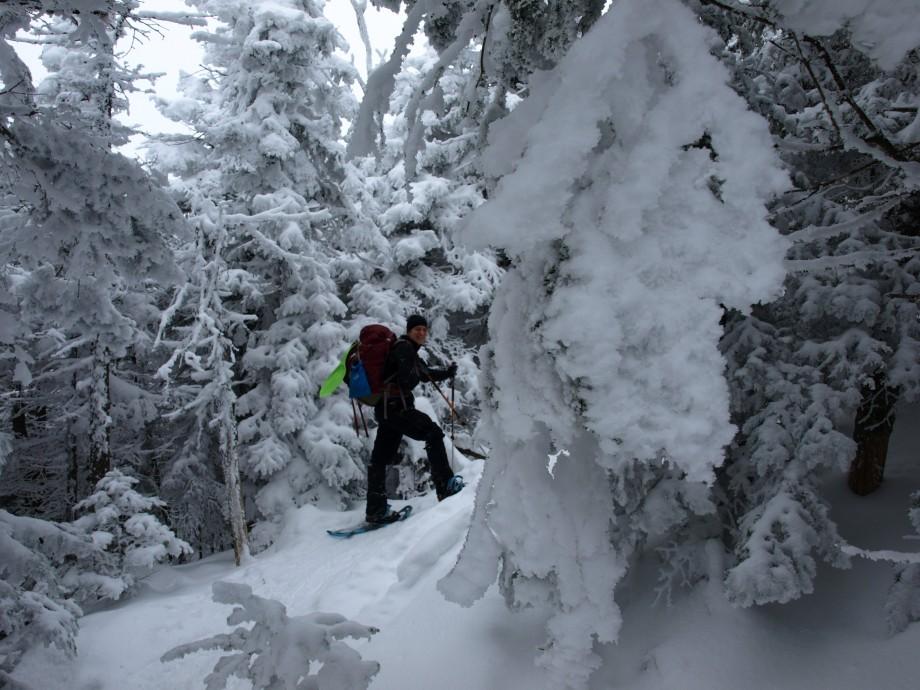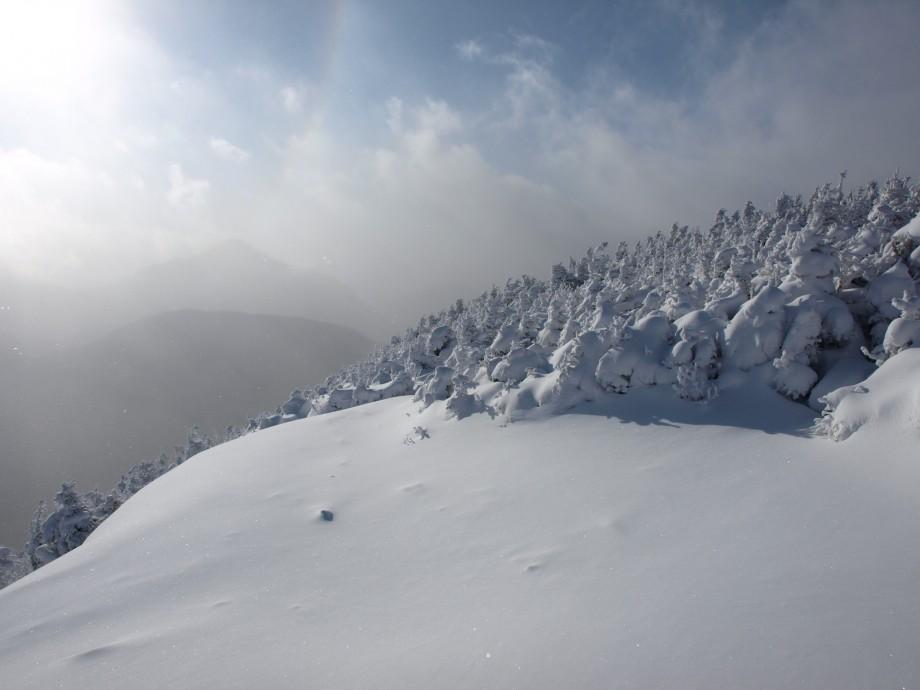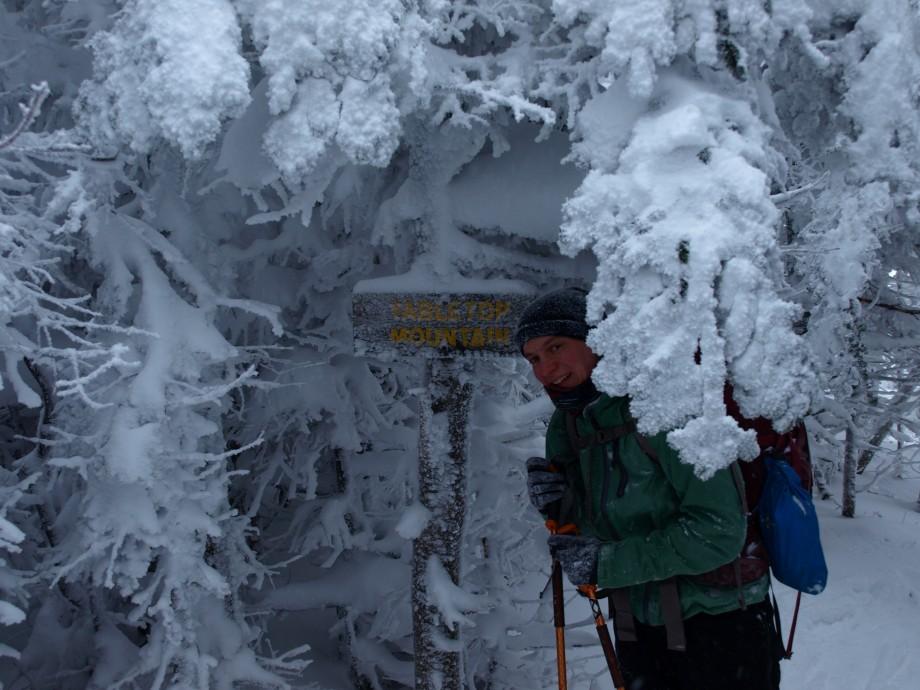The High Peaks
What’s the perfect choice for a first winter climb?
The High Peaks in winter can be very intimidating to climbers who have limited or no winter experience, but if you make the correct choices it shouldn’t be overwhelming. Yes, I would agree many of the High Peaks in winter are a grand undertaking and should not be a first winter peak. Many of the High Peaks require 10-12 hours of time in the woods and well over 12-miles during that day. However, with any mountain in winter there are a few things to keep in mind before you go out; am I equipped with the correct snowshoes? How am I going to protect myself from the cold and am I layered properly to stay warm (core, hands, feet, and head)? Do I have the proper nutrition? What’s the weather going to be like? Did I tell people where I was going? The list honestly goes on and on. But just as important, do I have the ability to tackle a High Peak or should I get a couple smaller peaks under my belt first.
Know your limits
I will admit to you, it took me three - four times to get Algonquin in the winter. It was during my youthful years and one of my first winter challenges, not my first High Peak in winter but one of them. The first time I was honestly not feeling well and very out of shape and bonked at tree-line. The second time I wasn’t properly dressed for the conditions above tree-line. My layers were not appropriate and my pants froze stiff upon the first real wind gust. The third time I bonked again not having had enough breakfast beforehand, or the wrong breakfast, I don’t honestly remember exactly, but my lack of nutrition did it. The fourth time the gods smiled upon me, or they felt sorry for me is more like it and I managed to get both Algonquin and Iroquois and then Wright on the way out. OK, the moral to this story is know your limits, be prepared and learn from your mistakes and do it right the next time.
High Peaks for a good start
That’s enough rambling on. If you want a winter High Peak under your belt, these are a good places to start, but as I mentioned you still need to be prepared. There are others that you might consider if you feel you up to a slightly larger challenge like; Esther, Big Slide and the Upper and Lower Wolf Jaw Mountains, again these might be better 2nd or 3rd peaks.

Cascade and Porter Mountains
This duo is the easiest of the High Peaks and in most cases can both be summitted in less than a full day’s time. Starting from Route 73 the trail begins moderate/easy as it skirts along the steep slopes. Eventually it gets a bit steeper and steadier but with small shelves in the trail to break up the constant climbing. Just shy of the summit of Cascade you meet and intersection with Porter on the right. Many summit Cascade first and then Porter. Cascade will become very rocky and windy once you break through the trees. Staying to the right will keep you out of the wind the most but to summit, you often have to fight heavy winds to even stand up. To grab Porter on your way out you will have a slight descent to a moderate ascent to an open summit with a great view of Cascade in the distance.

Phelps Mountain
Phelps has some serious bang for the buck, while the distance is a bit longer, the climb is relative short – but steep. Leaving from the Adirondack Loj you will have a nice stroll to and past Marcy Dam. Past Marcy Dam the grade slowly climbs, hardly noticeable, but you are gaining elevation. At the Phelps Mountain Trail intersection you will start a serious climb. It is very steep and can be quite slippery in areas with dust on ice conditions. As you top out on what looks to be the summit, you will need to continue back into the trees for a bit to a large open ledge with some very fine views of the High Peak Region.
Wright Peak
Wright Peak will push your limits a bit as a first peak, but not out of reach for many first timers. Starting again from the Adirondack Loj you will hike toward Marcy Dam for 0.9 miles to the intersection for Algonquin. Making that right you continue moderately before a steady climb is in front of you. As you approach 3000 feet in elevation the climbing is much steeper and then very steep, but you are almost to the crux of the hike. A short spur trail on the left will bring you to the open ridge on Wright. Be prepared for heavy winds and arctic temperatures, the conditions on this guy can be brutal.

Tabletop Mountain
If you are curious about the trailless peaks, Tabletop Mountain is one of them. Trailless means that the route is not marked but a well-defined herd-path does exist. Starting from the Adirondack Loj you will hike to and past Marcy Dam and continue on the trail toward Mount Marcy. The herd-path is reached only after about a mile of serious climbing, it will be on your left – a small sign marks its start. This trailless peak is easy to access, follow, and climb – making this a decent first peak, but with limited rewards. The summit is reached after hiking steadily uphill through a narrow corridor. Just past the summit decent views of the Upper Great Range can be had through the trees.
Time to plan your play
So that’s a starting point to working on the winter 46, is it a bible to follow, no. Only you know your abilities, but it’s a good direction for you to start. Want more information on the High Peaks – stop by a local bookstore and pick up a map and guide book. Prefer to have a guide for your first winter ascent – there are excellent guide services in Lake Placid with a winter 46er on staff. You might want some good hot food and a warm bed after you day in the crisp, fresh air – we got you covered. Have fun, be safe, take lots of pictures and come back to us for more mountain hijinks.





